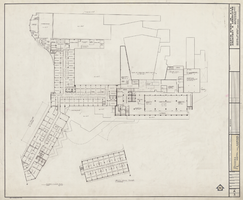Search the Special Collections and Archives Portal
Search Results

Architectural drawing of Riviera Hotel and Casino (Las Vegas), south wing addition typical luxury suite, August 4, 1965
Date
Archival Collection
Description
Corner guest room and typical luxury suite plans, elevations, and details for the addition of the south wing of the Riviera Hotel and Casino from 1965. Facsimile on parchment.
Site Name: Riviera Hotel and Casino
Address: 2901 Las Vegas Boulevard South
Image

Architectural drawing of Riviera Hotel and Casino (Las Vegas), tower addition site plan, December 12, 1973
Date
Archival Collection
Description
Site plan for 1974 additions and alterations to the tower of the Riviera Hotel. Drawn by T.P.A. Includes revision dates. Printed on mylar. John T. Iwamoto, delineator; Berton Charles Severson, architect; Brian Walter Webb, architect.
Site Name: Riviera Hotel and Casino
Address: 2901 Las Vegas Boulevard South
Image

Architectural drawing of Riviera Hotel and Casino (Las Vegas), tower addition, existing second floor master plan, circa December 1973
Date
Archival Collection
Description
Existing plans for the 1974 additions and alterations to the tower of the Riviera Hotel and Casino. Printed on mylar. John T. Iwamoto, delineator; Berton Charles Severson, architect; Brian Walter Webb, architect.
Site Name: Riviera Hotel and Casino
Address: 2901 Las Vegas Boulevard South
Image

Architectural drawing of Riviera Hotel and Casino (Las Vegas), tower addition master plans, December 12, 1973
Date
Archival Collection
Description
Basement, second floor, typical room, luxury suites, and penthouse master plans for the 1974 additions and alterations to the tower of the Riviera Hotel and Casino. Includes revision dates. Drawn by B.H. Printed on mylar. John T. Iwamoto, delineator; Berton Charles Severson, architect; Brian Walter Webb, architect.
Site Name: Riviera Hotel and Casino
Address: 2901 Las Vegas Boulevard South
Image

Architectural drawing of Riviera Hotel tower addition (Las Vegas), existing basement, second floor, and roof plans, December 12, 1973
Date
Archival Collection
Description
Existing basement plan for additions and alterations to the tower of the Riviera Hotel from 1974. Drawn by WMJ. Includes revision dates and key plan. Printed on mylar. John T. Iwamoto, delineator; Berton Charles Severson, architect; Brian Walter Webb, architect.
Site Name: Riviera Hotel and Casino
Address: 2901 Las Vegas Boulevard South
Image

Architectural drawing of Riviera Hotel tower addition (Las Vegas), first floor plan, section B, December 12, 1973
Date
Archival Collection
Description
Partial first floor plan for additions and alterations to the tower of the Riviera Hotel from 1974. Drawn by C. Includes revision dates and key plan. Printed on mylar. John T. Iwamoto, delineator; Berton Charles Severson, architect; Brian Walter Webb, architect.
Site Name: Riviera Hotel and Casino
Address: 2901 Las Vegas Boulevard South
Image

Architectural drawing of Riviera Hotel tower addition (Las Vegas), first floor plan, mezzanine plan, December 12, 1973
Date
Archival Collection
Description
First floor and mezzanine plans for additions and alterations to the tower of the Riviera Hotel from 1974. Drawn by FD and BH. Includes revision dates, notes, and key plan. Printed on mylar. John T. Iwamoto, delineator; Martin Stern Jr.; A.I.A Architect & Associates.
Site Name: Riviera Hotel and Casino
Address: 2901 Las Vegas Boulevard South
Image

Architectural drawing of Riviera Hotel tower addition (Las Vegas), second floor plan, December 12, 1973
Date
Archival Collection
Description
Second floor plan for additions and alterations to the tower of the Riviera Hotel from 1974. Includes revision dates, key plan, and washroom accessories table. Printed on mylar. John T. Iwamoto, delineator; Berton Charles Severson, architect; Brian Walter Webb, architect.
Site Name: Riviera Hotel and Casino
Address: 2901 Las Vegas Boulevard South
Image

Architectural drawing of Riviera Hotel tower addition (Las Vegas), Typical room plan and slab plan, December 12, 1973
Date
Archival Collection
Description
Typical hotel room plans for the third through 11th floors and slab plan for additions and alterations to the tower of the Riviera Hotel from 1974. Also drawn by C.J.S. Includes revision dates and key plan. Printed on mylar. John T. Iwamoto, delineator; Berton Charles Severson, architect; Brian Walter Webb, architect.
Site Name: Riviera Hotel and Casino
Address: 2901 Las Vegas Boulevard South
Image

Architectural drawing of Riviera Hotel tower addition (Las Vegas), luxury and penthouse suites, December 12, 1973
Date
Archival Collection
Description
Floor plans for the luxury suites on the 12th through the 16th floors, and the penthouse suite on the 17th floor for additions and alterations to the tower of the Riviera Hotel from 1974. Includes revision dates and key plan. Printed on mylar. John T. Iwamoto, delineator; Berton Charles Severson, architect; Brian Walter Webb, architect.
Site Name: Riviera Hotel and Casino
Address: 2901 Las Vegas Boulevard South
Image
